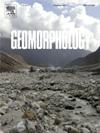Deciphering sediment connectivity dynamic in traditional water-meadows (lameiros)
IF 3.1
2区 地球科学
Q2 GEOGRAPHY, PHYSICAL
引用次数: 0
Abstract
Lameiros are traditional man-made water-meadows located at the bottom of the valleys in northern Portugal and northwestern Spain. Although lameiros act as hydrological and sediment accumulation regulators, this process has never been quantified in a spatially distributed manner (maps), nor have its temporal variations. For the first time, the role of lameiros in sediment connectivity is calculated by using the aggregated index of sediment connectivity (AIC) in two medium-size ungauged headwater basins with permanent and seasonal streams. Index parameterization was done in detail, including field surveys to distinguish the type, in-use (n = 21) or abandoned (n = 78), of lameiros and their water availability, well (n = 89) or poor (n = 10) irrigated. Different sedimentological scenarios that occur throughout the year were computed considering the net soil loss at the basin scale (target: watercourses; common conditions with the whole basin activated) and temporary accumulation in watercourses (target: outlet; dry conditions with sediment transport limited to the streams). The three erosive periods that happen during the year, i.e. high, medium and low rainfall erosivity, were simulated with long, average and short watercourses. Results of structural connectivity proved that the role played by each input (land-use, soil permeability, rainfall erosivity, slope gradient, drainage area, roughness of the terrain) on sediment connectivity strongly depended on the spatial location of each landscape unit regarding the selected target and not only on their own values. This fact explained the lower connectivity obtained in the abandoned lameiros than that found in the in-use lameiros. Map analysis indicated that during the dry period from May to September overland flow was restricted to the streams, sediment supply from slopes to lameiros was limited and the temporarily accumulated sediment in lameiros may be remobilized, while during the wet (January–April) and rainy (October–December) periods sediment supply from active slopes to lameiros was high and sediment delivery from lameiros to stream was relatively lower, acting as sedimentation-prone areas. Indeed, poor-irrigated lameiros had greater connectivity than well-irrigated lameiros. Connectivity of lameiros with their contributing areas (target: lameiros) was higher than that of the remaining land uses with the outlet and watercourses, proving the high sediment accessibility of this landscape feature. Index output performed well against available data of soil depth measured both in the lameiros and slopes. Multi-target computation of structural and functional connectivity concluded that sedimentation in lameiros prevailed against sediment delivery, although both processes occurred simultaneously throughout the year. This study suggests the convenience of preserving lameiros with some form of legal protection.

求助全文
约1分钟内获得全文
求助全文
来源期刊

Geomorphology
地学-地球科学综合
CiteScore
8.00
自引率
10.30%
发文量
309
审稿时长
3.4 months
期刊介绍:
Our journal''s scope includes geomorphic themes of: tectonics and regional structure; glacial processes and landforms; fluvial sequences, Quaternary environmental change and dating; fluvial processes and landforms; mass movement, slopes and periglacial processes; hillslopes and soil erosion; weathering, karst and soils; aeolian processes and landforms, coastal dunes and arid environments; coastal and marine processes, estuaries and lakes; modelling, theoretical and quantitative geomorphology; DEM, GIS and remote sensing methods and applications; hazards, applied and planetary geomorphology; and volcanics.
 求助内容:
求助内容: 应助结果提醒方式:
应助结果提醒方式:


